What do clown fish eat?
Before you add any fish to your aquarium, it’s important to consider the diet of the species you’re interested in. After all, some fish don’t eat as readily as others or have more complicated diets, making them unsuitable for beginners. Luckily this is not the case with clownfish!
So what does a clownfish eat? Let’s go into clownfish diet in the wild and in captivity, as well as how often and how much you should feed.
What does a clownfish eat in the wild?
Wild clownfish belong to the genera Ampiphrion and Premnas. They naturally occur in the Indian ocean, where they maintain symbiotic relationships with anemones. Part of their nutrition is provided by the anemone in the form of foods that get stuck in the tentacles. They’ll sometimes even take a bite out of the tentacles themselves.
Aside from what they can pick off their host, wild clownfish are omnivores that basically eat whatever they can find. They mainly live off zooplankton, a wide range of tiny creatures that float through the water column. This can include copepods, all sorts of larvae, fish eggs, small shrimp and more. They also feed on algae, though to a lesser degree.
What does a clownfish eat in the aquarium?
The fact that clownfish have such a varied diet in the wild (and are rather voracious!) is good news for aquarists. Unlike with some fish species, you really shouldn’t have any issues with getting your clown to eat. Additionally, they’re usually not very picky about what they consume either!
You can feed this species once a day, though it should be more if you’re planning on breeding clownfish. You can also consider twice or three times a day for juvenile specimens.
There are a whole bunch of different foods to try: high-quality marine pellets or flakes, (thawed) frozen foods like mysis, cyclops, brine shrimp, krill and more, live food like brine shrimp and vitamin-soaked freeze-dried food. For the veggie side of things, seaweed sheets (nori) and the occasional algae tab will work well if your clownfish are interested in them.
Tip: If you only just introduced your new clownfish to your aquarium, don’t worry if they don’t want to eat at first. Give them a few days to adjust and just keep trying daily!
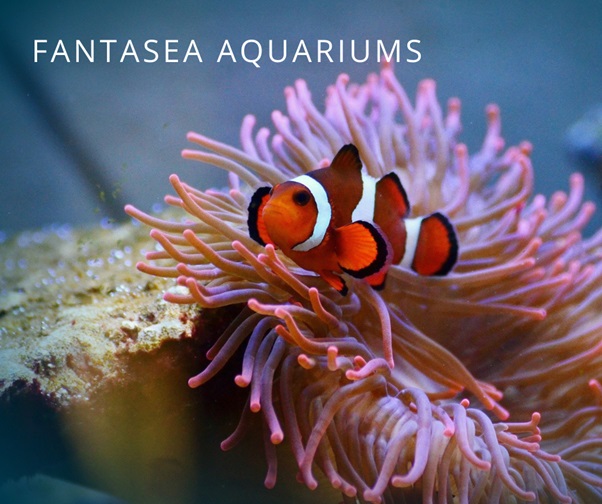
How much do clownfish eat?
As for quantity, first off, don’t fall for begging behavior. Your clownfish will learn to recognize you as the entity that feeds them and eventually start responding pretty enthusiastically to your presence! It’s important to remember that fish really don’t need that much food; overfeeding can lead to issues with water quality.
A commonly used trick for figuring out how much to feed is the eyeball method: feeding about as much as the size of the fish’s eye a day. That means a few pellets (probably 4-8) per fish, or a few pieces of frozen food. If you feed multiple times a day, cut the portion size in half. If your clownfish can’t finish its meal in a few minutes or leaves some of its food, consider feeding less next time.
If you’re worried you’re not feeding your clownfish enough or it’s not getting enough food, take a peek at its belly. It should be plump but not fat (although it can bulge a bit right after feeding). If the stomach looks sunken in, this means your fish is on the skinny side, which can be caused either by underfeeding or parasites.
What does a baby clownfish eat?
Clownfish larvae and very small clownfish are challenging to feed due to their size. Most aquarists feed rotifers at first, which means you’ll have to have a culture of these tiny critters set up before your clownfish eggs hatch. Later, you can switch to very fine fry foods and then crushed pellets or flakes.
If you’d like to find out more about breeding clownfish and feeding the fry, have a look at the guide to clownfish breeding.
What Do Clownfish Eat? 10+ Foods They Consume
Clownfish are prominent fish that stand out because of their bright orangish or reddish coloring and distinctive look. Most recently, people have become more knowledgeable about this species because of its feature in the film, Finding Nemo. Yet, there is more to this delightful fish than starring in animated films, starting with their symbiotic relationship with sea anemones, giving rise to their moniker, anemonefish. So, what do clownfish eat? How do they find food and stay out of harm’s way?
We’re going to consider at all these elements and show you why the clownfish is such an interesting sea creature.
What Foods Do Clownfish Eat?
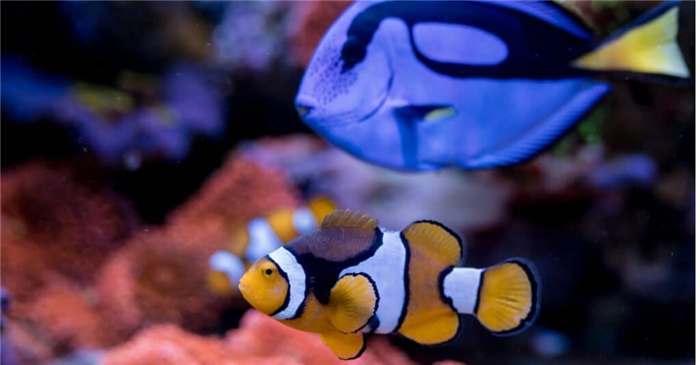
Clownfish are omnivores that eat plankton, algae, and shrimp.
Clownfish eat zooplankton, phytoplankton, algae, and a variety of other foods. They are omnivores that feed on a diverse selection of foods in the ocean. Part of their diet is based on what foods they capture on their own, but some other sources come from their symbiotic relationship with sea anemones. Consider the main foods that clownfish eat:
- Mysis shrimp
- Brine shrimp
- Zooplankton
- Phytoplankton
- Algae
- Smelt
- Black worms
- Copepods
- White worms (Enchytraeus albidus)
- Various leftover foods from the sea anemone
These are the more common foods that clownfish eat, and an interesting thing to note is that clownfish do not source all their meals in the wild. Instead, they form a symbiotic bond with sea anemones where the clownfish lives inside the flowery-looking predator’s tentacles. The fish generates mucus that protects it from the tentacles deadly sting, but other creatures are not so lucky.
When the sea anemone is finished eating something it has killed and captured, the clownfish will often eat what’s left. The clownfish also benefits the sea anemone by leaving some fecal matter for their hosts to consume, providing beneficial nutrients. This interesting living situation ensures the clownfish can find and consume food in relative peace.
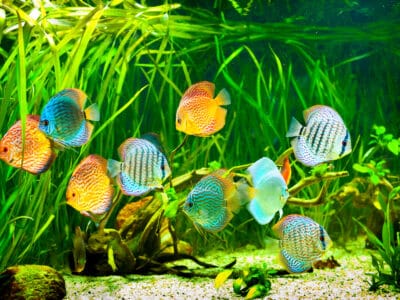
The Best Flake Food For Fish in 2022 – Reviewed and Ranked
What Do Clownfish Eat in Captivity?
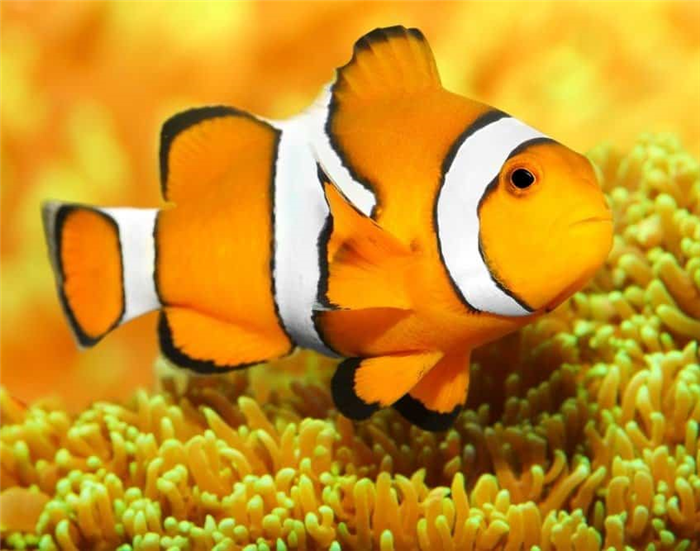
Clownfish mostly eat shrimp, worms, and prepared fish flakes in captivity.
Clownfish are a very popular tropical fish for people to keep as pets. As a result of their appearance in the aforementioned film series, these fish have become a hot commodity. In fact, they have been over-harvested from their natural habitats and now represent over 40% of the ornamental fish trade around the world, along with other members of the Pomacanthidae family.
The systematic removal of clownfish from their natural habitats has led to some areas of the world losing almost their entire population of anemonefish. They instead live in private aquariums where they rarely have a chance to breed while their natural habitat loses the benefit of their presence, especially the sea anemone.
When they are placed in aquariums, clownfish lose access to many of the foods that they commonly eat in the ocean, and they are often away from the sea anemone that leaves food for them.
In captivity, clownfish will commonly eat:
These are the most common foods available for clownfish when they are being kept in an aquarium or as a pet. These fish tend to be very territorial when they are introduced to a new setting, mostly as a result of their instincts to live in a sea anemone and rarely venture out of the habitat.
How Do Clownfish Find Food in the Wild?
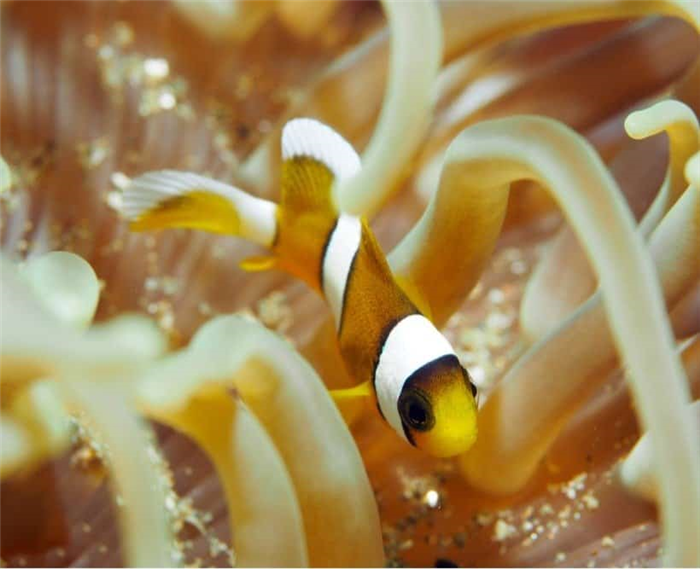
Clownfish will wait for the sea anemone to kill prey and then feed on the leftovers.
Clownfish find their food in the wild using several methods depending on what they’re trying to eat. As we have said before, the fish have a symbiotic relationship with sea anemones. Oftentimes, they will sit amongst the tentacles of the host and wait for something tasty to float by.
Sometimes, a small shrimp will float by that they can eat on their own, and other times they will wait for the sea anemone to kill one of its prey and then eat the leftovers that remain.
Clownfish rarely venture forth from the sea anemone because they immediately lose all their defenses by doing so. However, they will sometimes depart to forage on the surface of a nearby reef where they will look for plankton and algae.
Other times, they will spot one of their chosen foods floating in the water column, leave their safe space temporarily, and pick the food out of the water. They’re not tremendous hunters, merely very opportunistic creatures that benefit from having sea anemones to keep away predators.
What Predators Eat Clownfish?
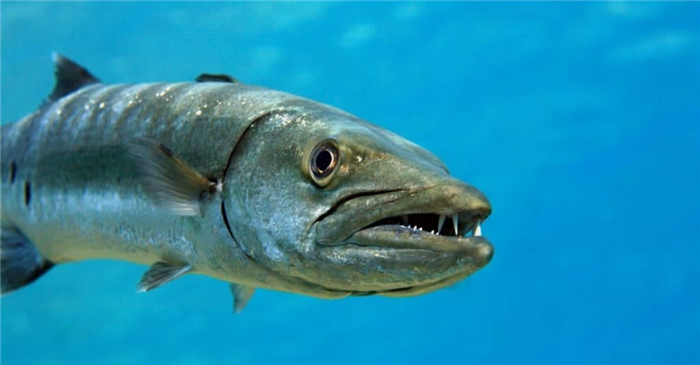
Barracudas have the speed to catch clownfish.
Clownfish have very few ways of protecting themselves since they are neither fast swimmers nor capable of fending off other predators. In fact, their best means of protection come from the sea anemone. Although some predators will learn a painful or deadly lesson charging into the sea anemone in pursuit of a clownfish, sometimes they can successfully catch an anemonefish through patience alone.
As we’ve mentioned, clownfish will sometimes leave the safety of their living area to graze on the reef. That is when predators will strike, swooping in for a quick meal or netting them so they can be sold to others.
These are the most frequent predators of clownfish:
The barracudas are fast swimmers and have long snouts that can snatch up clownfish with ease, but it’s the humans that clownfish need to worry about. Millions of these fish have been plucked out of their native waters to decorate aquariums and live out their lives as pets. They require careful housing and the presence of an anemone in their tank if they’re survive for a long time.
Unfortunately, humans are also harming the reefs clownfish live in and have been cutting down on the native populations, reducing the number of anemonefish in the ocean. The overall impact on the species is unknowable right now, but no creature poses so much danger to clownfish as humans.
Clownfish are famous yet shy omnivores that feed on shrimp, other fish, and various planktons. Their symbiotic relationship with sea anemones is remarkable and helps keep them safe and well-fed. Although these fish are beautiful, their physical characteristics and presence in films have made them a target for humans to collect, and the species may be headed down a dire path as a result.
Share this post on:
Kyle Glatz
I’m a freelance writer with 8 years of experience. I’ve written in a variety of niches such as video games, animals, and managed service providers. I graduated from Rowan University in 2014 with degrees in English and Education. When I’m not working, I enjoy playing video games, reading, and writing for fun.
What Do Clownfish Eat? What Food Is Unfavorable For Them?
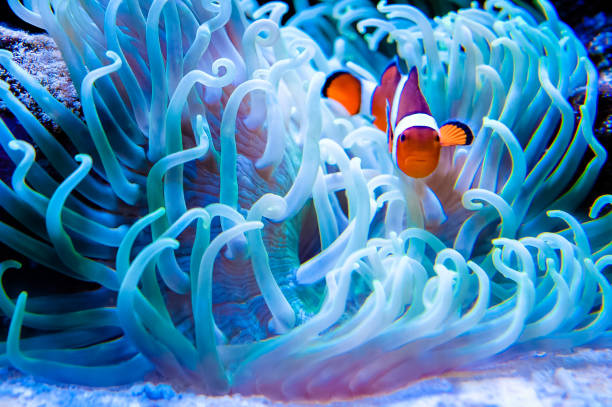
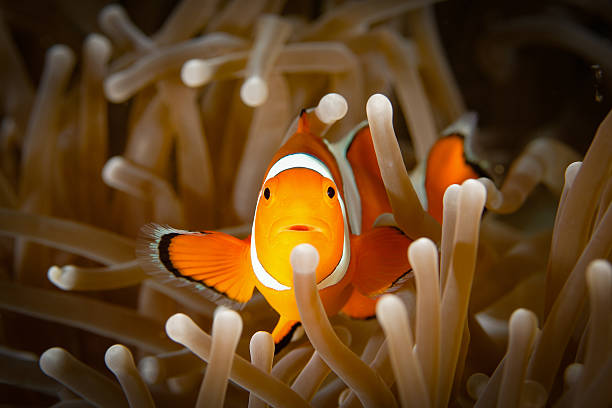
Show all photos 1
Published on Nov 24, 2021
Get inspiration for education!
Subscribe for virtual tools, STEM-inspired play, creative tips and more
Clownfish is a member of the Pomacentridae family’s Amphiprioninae.
The clownfish, well recognized for its appearances in films like ‘Finding Nemo’ and ‘Finding Dory,’ seems to have become a famous ornamental companion. Alongside his father, Marlin, Nemo was an ocellaris clownfish, often known as clown anemonefish or fake percula clownfish.
Anemonefish gets its title from the sea anemones within whom they live. There seem to be around 30 anemonefish species, which can appear in a range of hues, including pink, crimson, yellowish, black, brownish, orange, and multi-colored patterns. As per the Animal Diversity Web, their bodies are somewhat longer than 3 in (7.62 cm) in general, although they can expand up to 4 in (10.16 cm). The tail is orbital in shape, and the dorsal fin has 11 spines.
Clownfish have a short, flat body with a protruding dorsal fin. The caudal fins are used as a propeller, helping them to move forward. Mainly during a full moon, female clownfish may lay up to 1,000 eggs. Clownfish are omnivores, and they are often naturally aggressive and threatening. Clownfish are not always the most skilled swimmer in the sea. In captivity, they have a lifespan of around three to six years, while in the wild, it is approximately 6-10 years.
To purchase a clownfish, you can expect to pay anywhere between $19.99 to $99.99 depending on the breed desired. After reading about the suitable diet for a clownfish in an aquarium, also check why do fish jump and how often do you feed a betta fish?
What do clownfish eat in the coral reef?
Clownfish dwell in the protection of reefs. False clownfish may be found on coral reefs off of the shores of Australia and Southeast Asia, all the way up to southern Japan.
Here their diet features a variety of food products like fish eggs, worms, zooplankton, and small crustaceans.
These are frequently located near anemones, which are creatures that attach themselves to the sea bottom and utilize their tendrils to lure food. Once the prey or predators come in contact with the anemone’s tentacles, stinging structures called nematocysts emit a poison. However, clownfish build a tolerance to the poison by emitting mucus to protect their body. This allows them to enter a symbiotic relationship.
What do clownfish eat in the Great Barrier Reef?
Clownfish aren’t fussy eaters. Clownfish devour anything within their native habitat, which would include copepods, tiny crustaceans, larvae, fish eggs, and phytoplankton.
Wild clownfish being omnivores, can consume everything they can get their hands on. They primarily feed on zooplankton, a diverse group of small animals that drift across the water column. Copepods, various larvae, fish eggs, tiny shrimp, and other organisms may be included. They also graze on algae, but to a lesser extent.
Clownfish live in anemones and may be discovered in warm areas such as the Red Sea and Pacific Oceans. Clownfish consume a variety of tiny invertebrates and algae and also food leftovers left behind by anemones. Their primary food sources are algae, zooplankton, and small crustaceans.
Do clownfish eat plankton?
Clownfish are omnivores, meaning they consume both meat and vegetables. As per National Aquarium, they generally consume algae, plankton, larvae, and tiny crustaceans.
The wild clownfish’s food consists mainly of plankton and seagrasses. Clownfish may consume both marine vegetation and tiny sea creatures. It can devour their companion anemone’s unprocessed or leftover food. However, zooplankton is their principal dietary supply.
They survive primarily by eating on plankton and algae. These fishes, described as ‘plankton pickers,’ locate and specifically target plankton drifting in the surrounding water before consuming them. This differs from filter-feeding, which requires sifting massive amounts of plankton via mouth to gain nutrients.
As clownfish primarily are saltwater creatures, they consume saltwater copepods. Most of these copepods resemble plankton, meaning they swim or wander in the water. Certain copepods are littoral, meaning they reside on the seafloor.
Do clownfish eat live brine shrimp?
Clownfish are among the few tropical fish which can be offered fish flake meal. A clownfish’s nutrition is diversified throughout the wild, which also implies that the clownfish may thrive if folks try to recreate that natural diet as closely as possible.
The easiest method to accomplish this is to offer them meat meals like brine shrimp, krill, or mysis while also guaranteeing that the fish receive daily algae. Brine shrimp are a type of crustaceans that is also known as artemia and sea-monkeys. Their physical structure is similar to that of shrimp. They can live in warm waters with salinities as high as 25%.
Saltwater living meals like brine shrimp, sometimes called sea monkeys or copepods, which are tiny crustaceans, will be devoured by the clownfish in no time. Copepods and brine shrimp are tiny, making them ideal for little fish and picky eaters.
Brine shrimp are sometimes offered in large quantities in a single feeding, and you’ll need to put up a small storage tank to preserve the extra. Defrosted brine shrimp is indeed an elevated snack that is suitable for both fresh and saltwater fish. These may also be obtained from pet stores on the internet and also in most fishing shops. Brine shrimp are full of protein, making for a healthy meal.
Do clownfish eat leftovers?
The clownfish and the anemone have a symbiotic connection. The anemone offers necessary protections to the clownfish and supplies leftovers, whereas the clownfish takes nourishment to the anemone and preens its hosts, eradicating parasites.
Ensure that the fish consume all of the foodstuffs you have placed in their aquarium inside the time span you have set. If there is any meal remaining, you likely gave them more than they required. If you settle upon four minutes, continue modifying the meal amount till they complete the meal inside the time limit. They should eat three to four times every day.
The fish would merely create more excrement, and the remaining food will degrade the water supply in the aquarium. If you ever do not eliminate the remnants, it will be even more dangerous. It all might appear complicated; however, it is not. It may take a little time, but you might quickly be able to identify how much or how frequently you should feed.
Snails, crabs, or starfish may assist in wiping up leftovers while also providing some for the children or visitors to wonder at. Clownfish habitat features sheltered reefs where the strong water flow does not pose any danger. Their habitat primarily spans across the reeds on the Indian Ocean and the Pacific Ocean.
Be it an adult clownfish or a juvenile clownfish, a smaller fish, and it is necessary to feed your orange clownfish more food with a varied diet with all the nutrients on a proper feeding schedule. If you feed your clownfish or any other fish species in such an appropriate type and amount of food, it will result in a long life at the same time with a proper clownfish diet.
Even when your clownfish prefer to eat individual zooplankton or phytoplankton floating in the water column, which might not be too nutritious, feeding clownfish some nutritious live fish food may be necessary. When taking care of your clownfish feeding, give it the best food to be eaten, like shrimps such as krill, mysis, and brine which act to be a great source of nutrients as live fish food.
They even happily nibble on some of the best food in the frozen food category. The frozen food may include small frozen fish, cut-up bloodworms. Make sure to clean the excess food from the water once they are done eating. The clownfish will even eat sea fish foods. The sea fish foods may include cooked mussels.
What do clownfish eat in captivity?
There may even be a debate whether only live foods are suitable for the fish and frozen foods are bad for the fish. Maybe it is true for some species of the fishes, but not in the case of a clownfish. Be it live foods or frozen foods, and your clownfish will chomp on either of the live foods or frozen foods happily.
Avid omnivores eat anything within their native environment, such as tiny crustaceans, copepods, phytoplankton, fishes, and anemone tendrils. When housed in an aquarium, these hungry omnivores will happily consume a wide range of fish meals. You could even give them flake food scraps, which is exceptionally uncommon for sea creatures to consume.
Clownfish require a fresh fish meal to grow. The most straightforward technique to acquaint wild types of fish, including clownfish, in its newer, smaller environment is to feed them live items. Shrimps like krill, mysis, and brine are the most incredible live meals to give the clownfish.
The clownfish will happily nibble on little frozen fish, trimmed Bloodworms, and table shrimp when it comes to frozen meals. Cooked mussel, chicken livers, clams, raw fish, sliced octopus, minced squid, and skinned shrimp bits are some alternative frozen fish food possibilities for your clownfish. You may incorporate nori weed and spinach as veggies.
Chard and boiled spinach also are excellent veggie foods for clownfish. Snails, sea urchins, or crabs can be added to the clownfish tank as a food cleaning crew. They will devour any food scraps from the clownfish, keeping your tank clean and algae-free.
Here at Kidadl, we have carefully created lots of interesting family-friendly facts for everyone to enjoy! If you liked our suggestions for what do clownfish, eat then why not take a look at how often to feed fish or how often to feed fish?
Written By
The Kidadl Team is made up of people from different walks of life, from different families and backgrounds, each with unique experiences and nuggets of wisdom to share with you. From lino cutting to surfing to children’s mental health, their hobbies and interests range far and wide. They are passionate about turning your everyday moments into memories and bringing you inspiring ideas to have fun with your family.
Read The Disclaimer
Disclaimer
At Kidadl we pride ourselves on offering families original ideas to make the most of time spent together at home or out and about, wherever you are in the world. We strive to recommend the very best things that are suggested by our community and are things we would do ourselves – our aim is to be the trusted friend to parents.
We try our very best, but cannot guarantee perfection. We will always aim to give you accurate information at the date of publication – however, information does change, so it’s important you do your own research, double-check and make the decision that is right for your family.
Kidadl provides inspiration to entertain and educate your children. We recognise that not all activities and ideas are appropriate and suitable for all children and families or in all circumstances. Our recommended activities are based on age but these are a guide. We recommend that these ideas are used as inspiration, that ideas are undertaken with appropriate adult supervision, and that each adult uses their own discretion and knowledge of their children to consider the safety and suitability.
Kidadl cannot accept liability for the execution of these ideas, and parental supervision is advised at all times, as safety is paramount. Anyone using the information provided by Kidadl does so at their own risk and we can not accept liability if things go wrong.
Sponsorship & Advertising Policy
Kidadl is independent and to make our service free to you the reader we are supported by advertising.
We hope you love our recommendations for products and services! What we suggest is selected independently by the Kidadl team. If you purchase using the buy now button we may earn a small commission. This does not influence our choices. Please note: prices are correct and items are available at the time the article was published.
Kidadl has a number of affiliate partners that we work with including Amazon. Please note that Kidadl is a participant in the Amazon Services LLC Associates Program, an affiliate advertising program designed to provide a means for sites to earn advertising fees by advertising and linking to amazon.
We also link to other websites, but are not responsible for their content.
Do Clownfish Eat Their Babies?
There is some debate surrounding the eating habits of clownfish, as some believe that they do eat their young, while others maintain that this is not the case. Regardless of whether or not clownfish actually consume their young, it is clear that they are very protective of them and will go to great lengths to protect them. If a clownfish is in danger, it will use all of its energy to protect itself and its offspring.
Clownfish eat small fish and other things that they find in the water. Some people think that clownfish eat their own eggs because their stomachs look like they could fit a lot of eggs inside them. However, scientists haven’t been able to prove whether or not clownfish actually eat their own eggs.
